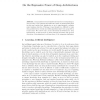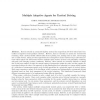15 search results - page 3 / 3 » Swarm intelligence in e-learning: a learning object sequenci... |
ISMIS
2009
Springer
13 years 11 months ago
2009
Springer
Many clustering methods are based on flat descriptions, while data regarding real-world domains include heterogeneous objects related to each other in multiple ways. For instance,...
ATAL
2010
Springer
13 years 5 months ago
2010
Springer
Multi-agent learning is a crucial method to control or find solutions for systems, in which more than one entity needs to be adaptive. In today's interconnected world, such s...
ALT
2011
Springer
12 years 4 months ago
2011
Springer
Deep architectures are families of functions corresponding to deep circuits. Deep Learning algorithms are based on parametrizing such circuits and tuning their parameters so as to ...
APIN
1998
13 years 4 months ago
1998
Abstract. Recent research in automated highway systems has ranged from low-level vision-based controllers to high-level route-guidance software. However, there is currently no syst...
GECCO
2009
Springer
13 years 11 months ago
2009
Springer
Tetris is a falling block game where the player’s objective is to arrange a sequence of different shaped tetrominoes smoothly in order to survive. In the intelligence games, ag...


